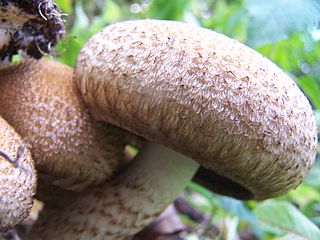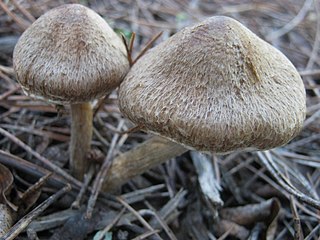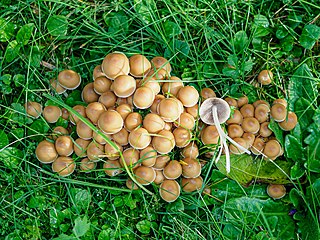
Lucien Quélet was a French naturalist and mycologist. Quélet discovered several species of fungi and was the founder of the Société mycologique de France, a society devoted to mycological studies.

Mythicomyces is a fungal genus in the family Mythicomycetaceae. A monotypic genus, it contains the single species Mythicomyces corneipes, first described by Elias Fries in 1861. The fungus produces fruit bodies with shiny yellowish-orange to tawny caps that are 1–3 cm (0.4–1.2 in) in diameter. These are supported by stems measuring 2–5.7 cm (0.8–2.2 in) long and 1–2 mm thick. A rare to uncommon species, it is found in northern temperate regions of North America and Europe, where it typically fruits in groups, in wet areas of coniferous forests. There are several species with which M. corneipes might be confused due to a comparable appearance or similar range and habitat, but microscopic characteristics can be used to reliably distinguish between them.

Robert Kühner was a French mycologist most notable for reviewing many forms of agaric genera.

Mycena vitilis, commonly known as the snapping bonnet, is a species of inedible mushroom in the family Mycenaceae. It is found in Europe and North America, where it grows on the ground among leaves in damp places, especially under alder. The small pale gray to whitish fruit bodies are usually attached to small sticks buried in the leaves and detritus. They are distinguished by their long, slender stems that root into the ground, and by the grooved cap that reaches diameters of up to 2.2 cm (0.9 in). The grayish-white gills on the underside of the cap are distantly spaced, and adnately attached to the stem. M. vitilis contains strobilurin B, a fungicidal compound with potential use in agriculture.

Pluteus cyanopus is a species of agaric fungus in the family Pluteaceae. Found in Africa, Europe, and North America, its fruit bodies contain the psychoactive compounds psilocybin and psilocin. The species was first described scientifically by French mycologist Lucien Quélet in 1883.

Tulosesus impatiens is a species of fungus in the family Psathyrellaceae. First described in 1821, it has been classified variously in the genera Psathyrella, Pseudocoprinus, Coprinarius, and Coprinus, before molecular phylogenetics reaffirmed it as a Coprinellus species in 2001. The fungus is found in North America and Europe, where the mushrooms grow on the ground in deciduous forests. The fruit bodies have buff caps that are up to 4 cm (1.6 in) in diameter, held by slender whitish stems that can be up to 10 cm (3.9 in) tall. Several other Coprinopsis species that resemble C. impatiens may be distinguished by differences in appearance, habit, or spore morphology.

Leucangium is a genus of ascomycete fungi. The genus was circumscribed by French mycologist Lucien Quélet in 1883. Although classified in the Helvellaceae in the past, molecular analysis indicates it is closely related to the genus Fischerula and Imaia, and therefore must be placed in the Morchellaceae. The genus includes two species, Leucangium ophthalmosporum Quél. and L. carthusianum Paol., and both of them produce sequestrate ascoma, globose to ellipsoidal ascus, and dark olive-colored to grayish green, smooth, fusiform ascospores.

Marasmius bulliardii is a species of agaric fungus in the family Marasmiaceae. It was first described scientifically by French mycologist Lucien Quélet in 1878.

Mycena tintinnabulum is a European species of agaric fungus in the family Mycenaceae. The mycelium, but not the fruit body, is bioluminescent.

Russula raoultii is an inedible species of agaric fungus in the family Russulaceae. It was first described by French mycologist Lucien Quélet in 1886.

Psathyrella longipes, the tall Psathyrella, is a species of agaric fungus in the family Psathyrellaceae and the brittlestem genus, Psathyrella. It was originally described as Hypholoma longipes by Charles Horton Peck in 1895; Alexander H. Smith transferred it to Psathyrella in 1941.

Psathyrella echiniceps is a species of agaric fungus in the family Psathyrellaceae. First described under the name Hypholoma echiniceps by George F. Atkinson in 1909, it was transferred to the genus Psathyrella by Alexander H. Smith in 1972. It is found in the US states of California, Idaho, Maryland, Michigan, New York, Ohio, Oregon, and Washington, where it grows in small groups around hardwood stumps.

Russula violeipes, commonly known as the velvet brittlegill, is a species of fungus in the family Russulaceae. It was described by French mycologist Lucien Quélet in 1898. An edible mushroom, it is found in Asia and Europe.
Chalciporus amarellus is a bolete fungus of the family Boletaceae, native to Europe. It was first described in 1883 by French mycologist Lucien Quélet as Boletus amarellus, and later transferred in genus Chalciporus by Frédéric Bataille in 1908.

Xeromphalina cornui is a species of agaric fungus in the family Mycenaceae. It was originally described in 1866 by French mycologist Lucien Quélet as Omphalia cornui; Swiss naturalist Jules Favre transferred it to Xeromphalina in 1936.

Inosperma bongardii is an agaric fungus in the family Inocybaceae. It was originally described as a species of Agaricus by German botanist Johann Anton Weinmann in 1836. Lucien Quélet transferred it to the genus Inocybe in 1872. A 2019 multigene phylogenetic study by Matheny and colleagues found that I. bongardii and its relatives in the subgenus Inosperma were only distantly related to the other members of the genus Inocybe. Inosperma was raised to genus rank and the species became Inosperma bongardii.

Psathyrella atrospora is a species of mushroom in the family Psathyrellaceae. Found in North America, it was described as new to science in 1972 by mycologist Alexander H. Smith.
Clavaria versatilis is a species of coral fungus in the family Clavariaceae. It was first described scientifically by French mycologist Lucien Quélet in 1893 as a species of Ramaria. Pier Andrea Saccardo and Alessandro Trotter transferred it to the genus Clavaria in 1912.

Britzelmayria multipedata is a species of mushroom producing fungus in the family Psathyrellaceae. It is commonly known as the clustered brittlestem.

















